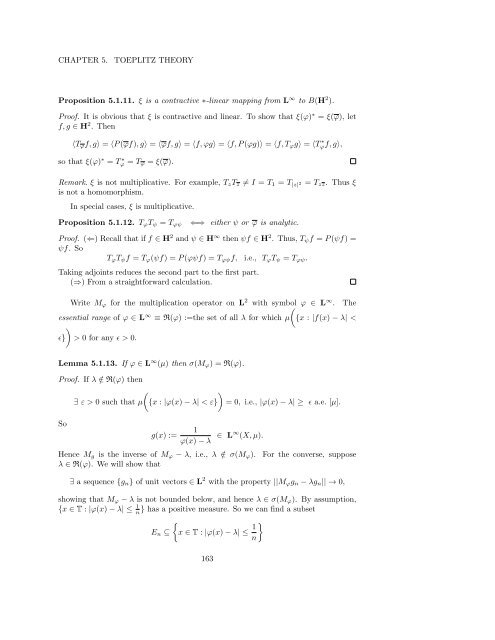Woo Young Lee Lecture Notes on Operator Theory
Woo Young Lee Lecture Notes on Operator Theory
Woo Young Lee Lecture Notes on Operator Theory
You also want an ePaper? Increase the reach of your titles
YUMPU automatically turns print PDFs into web optimized ePapers that Google loves.
CHAPTER 5.<br />
TOEPLITZ THEORY<br />
Propositi<strong>on</strong> 5.1.11. ξ is a c<strong>on</strong>tractive ∗-linear mapping from L ∞ to B(H 2 ).<br />
Proof. It is obvious that ξ is c<strong>on</strong>tractive and linear. To show that ξ(φ) ∗ = ξ(φ), let<br />
f, g ∈ H 2 . Then<br />
⟨T φ f, g⟩ = ⟨P (φf), g⟩ = ⟨φf, g⟩ = ⟨f, φg⟩ = ⟨f, P (φg)⟩ = ⟨f, T φ g⟩ = ⟨T ∗ φf, g⟩,<br />
so that ξ(φ) ∗ = T ∗ φ = T φ = ξ(φ).<br />
Remark. ξ is not multiplicative. For example, T z T z ≠ I = T 1 = T |z| 2<br />
is not a homomorphism.<br />
In special cases, ξ is multiplicative.<br />
= T zz . Thus ξ<br />
Propositi<strong>on</strong> 5.1.12. T φ T ψ = T φψ<br />
⇐⇒ either ψ or φ is analytic.<br />
Proof. (⇐) Recall that if f ∈ H 2 and ψ ∈ H ∞ then ψf ∈ H 2 . Thus, T ψ f = P (ψf) =<br />
ψf. So<br />
T φ T ψ f = T φ (ψf) = P (φψf) = T φψ f, i.e., T φ T ψ = T φψ .<br />
Taking adjoints reduces the sec<strong>on</strong>d part to the first part.<br />
(⇒) From a straightforward calculati<strong>on</strong>.<br />
Write M φ for the multiplicati<strong>on</strong> operator <strong>on</strong> L 2 with symbol<br />
(<br />
φ ∈ L ∞ . The<br />
essential range of φ ∈ L ∞ ≡ R(φ) :=the set of all λ for which µ {x : |f(x) − λ| <<br />
)<br />
ϵ} > 0 for any ϵ > 0.<br />
Lemma 5.1.13. If φ ∈ L ∞ (µ) then σ(M φ ) = R(φ).<br />
Proof. If λ /∈ R(φ) then<br />
(<br />
)<br />
∃ ε > 0 such that µ {x : |φ(x) − λ| < ε} = 0, i.e., |φ(x) − λ| ≥ ϵ a.e. [µ].<br />
So<br />
g(x) :=<br />
1<br />
φ(x) − λ ∈ L∞ (X, µ).<br />
Hence M g is the inverse of M φ − λ, i.e., λ /∈ σ(M φ ). For the c<strong>on</strong>verse, suppose<br />
λ ∈ R(φ). We will show that<br />
∃ a sequence {g n } of unit vectors ∈ L 2 with the property ||M φ g n − λg n || → 0,<br />
showing that M φ − λ is not bounded below, and hence λ ∈ σ(M φ ). By assumpti<strong>on</strong>,<br />
{x ∈ T : |φ(x) − λ| ≤ 1 n<br />
} has a positive measure. So we can find a subset<br />
{<br />
E n ⊆ x ∈ T : |φ(x) − λ| ≤ 1 }<br />
n<br />
163













